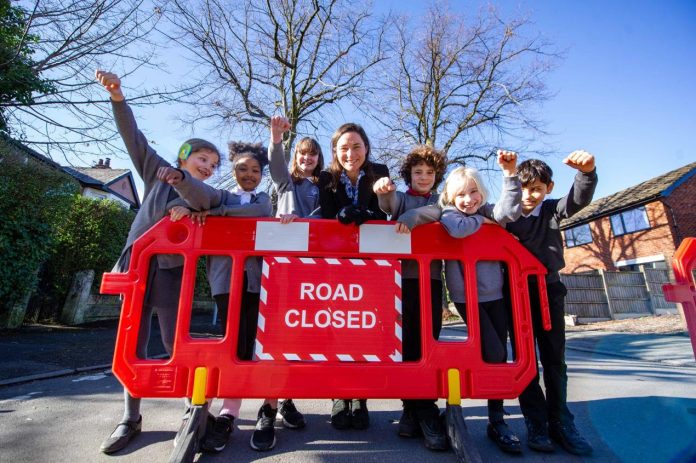Children and parents are making the most of safely walking and wheeling to and from a primary school in south Manchester thanks to an active travel zone around the school gates at pick-up and drop-off times.
Manley Park Primary School in Whalley Range is one of seven primaries to adopt a ‘School Street’ in Manchester, enabling pupils to make their way to and from school in a pleasant, safe environment that prioritises active travel over driving on the school run.
The zone is implemented outside the primary school between Upper Chorlton Road and Park Drive five days a week during term time before and after the school day between 8-9am and 2-3.30pm.
The trial initiative is a partnership between the school, Manchester City Council and Transport for Greater Manchester.
Active Travel Commissioner Dame Sarah Storey paid Manley Park Primary a visit to see their new ‘School Street’ in action on Friday.
In November, Dame Sarah unveiled a new policy, Refreshing Greater Manchester’s Active Travel Mission, highlighting the benefits of active travel and why it is fundamental to the success of other key agendas for Greater Manchester, including a ‘vision zero’ recommendation for road danger reduction .
Home to school travel is also one of the commissioner’s key priorities to ensure that educational establishments have the tools to support youngsters in participating in active travel.
Dame Sarah Storey said: “I was really impressed with the positive action teachers, parents, and volunteers are taking to create a safe environment around Manley Park Primary School during drop-off and pick-up times.
“A School Street’s main function is to improve the safety of children as they head to and go home from school. With Vision Zero a key recommendation within my recent Refresh the Mission report, local interventions like this make a significant contribution to reducing road danger, as well as improving the air quality around the school gate.
“It’s clear that this School Street is benefitting school pupils and enabling them to enjoy a more active journey to and from school every day.”
Across GM, around 30% of trips under 1km are made in a car, with 84% of school runs being under 1-mile. That’s the equivalent of a four-minute bike ride or a 15-minute walk.
The aim of the School Streets scheme is to help create a pleasant, child-friendly, safe environment, which prioritises active travel over driving, enabling children to breathe cleaner air on the school run.
In most cases, a School Streets project consists of a traffic regulation order and related signage, but the programme isn’t a one-size-fits-all approach. Each School Street scheme is unique to the community and the needs of the school, with each school set to adapt its measures accordingly.
Marshals put out signs, cones and barriers to highlight the scheme while residents and businesses on the street are still allowed to use the road if they drive at a walking pace and they show a valid permit. Blue badge holders and emergency service vehicles can still maintain access to the street too.
Rob Jones, Deputy Head at Manley Park Primary School, said: “We are so proud to be the first Manchester School to launch our School Street. The project fully supports our school vision of developing pupils to be socially responsible citizens of our community and the world.
“Before we started the trial, traffic on the road at pick up and drop of times was incredibly busy, causing high levels of stress and a potentially dangerous environment for all of those involved.
“Now, the atmosphere at the beginning and end of the school day is a tranquil one, and many of our children have spoken about feeling safe as they make their way to and from school. I would like to say a huge thank you to all the volunteers and to TfGM for making this a reality for our school and the local community.”
Councillor Tracey Rawlins, Executive Member for Environment and Highways added:
“The Council has recently set out our active travel strategy for the next five years, as part of this we have committed to expanding the network of School Streets.
“We believe there are significant benefits this initiative can bring – most importantly improving safety – but also encouraging more children to walk, wheel or cycle to school, as well as helping to cut down pollution from idling cars at drop off and pick up time.”
The School Streets scheme and ethos support The Bee Network, Greater Manchester’s vision for an integrated transport network that connects all forms of public transport, including cycling and walking.
Active travel, a key element of the Bee Network ambition, will enable more people to travel sustainably on everyday trips or as part of a longer journey using public transport, and will contribute to the city-region’s aim to become carbon neutral by 2038.
On Friday, the government published its latest capability ratings for active travel across the country.
The ratings, assessed and published by Active Travel England, are an objective assessment of each authority’s ability to increase active travel and ensure public money is targeted to deliver the most benefits.
Greater Manchester CA was one of just five of the 79 local transport authorities in the country to score a rating of 3 for its ‘very strong local leadership, comprehensive plans and a significant network in place with a growing number of people choosing to walk, wheel and cycle.’ The ratings will be used to guide the allocation of funding and other resources.







